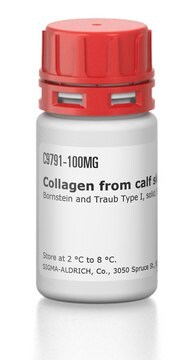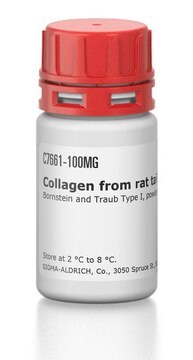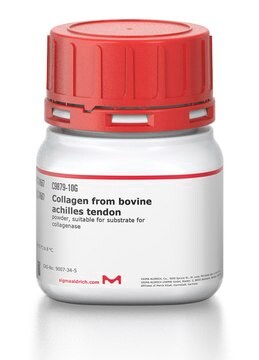C8919
Collagen from calf skin
Bornstein and Traub Type I, (0.1% solution in 0.1 M acetic acid), aseptically processed, BioReagent, suitable for cell culture
About This Item
Produits recommandés
Source biologique
bovine (calf) skin
Niveau de qualité
Stérilité
aseptically processed
Gamme de produits
BioReagent
Forme
solution (0.1% solution in 0.1 M acetic acid)
Conditionnement
pkg of 20 mL
Disponibilité
not available in Canada (at this time; for questions or status updates, please email us at antibody.canada@sial.com)
Concentration
(0.1% solution in 0.1 M acetic acid)
Technique(s)
cell culture | mammalian: suitable
Couverture de surface
6‑10 μg/cm2
Spécificité de la liaison
Peptide Source: Collagen
Peptide Source: Elastin
Peptide Source: Fibronectin
Conditions d'expédition
wet ice
Température de stockage
2-8°C
Informations sur le gène
bovine ... COL1A1(282187) , COL2A1(407142)
Vous recherchez des produits similaires ? Visite Guide de comparaison des produits
Catégories apparentées
Description générale
Application
- for pre-coting glass slides for immunofluorescence studies
- as a cell adhesion factor and modification of poly(vinylidene fluoride-trifluoroethylene) (P(VDF-TrFE)) films for neuron culture
- for coating culture dishes for murine embryonic fibroblasts culture
Actions biochimiques/physiologiques
Composants
Notes préparatoires
Autres remarques
Code de la classe de stockage
12 - Non Combustible Liquids
Classe de danger pour l'eau (WGK)
nwg
Point d'éclair (°F)
Not applicable
Point d'éclair (°C)
Not applicable
Certificats d'analyse (COA)
Recherchez un Certificats d'analyse (COA) en saisissant le numéro de lot du produit. Les numéros de lot figurent sur l'étiquette du produit après les mots "Lot" ou "Batch".
Déjà en possession de ce produit ?
Retrouvez la documentation relative aux produits que vous avez récemment achetés dans la Bibliothèque de documents.
Articles
Attachment Factors for 3-Dimensional Cell Culture
The extracellular matrix (ECM) is secreted by cells and surrounds them in tissues.
Cancer stem cell media, spheroid plates and cancer stem cell markers to culture and characterize CSC populations.
Extracellular matrix proteins such as laminin, collagen, and fibronectin can be used as cell attachment substrates in cell culture.
Notre équipe de scientifiques dispose d'une expérience dans tous les secteurs de la recherche, notamment en sciences de la vie, science des matériaux, synthèse chimique, chromatographie, analyse et dans de nombreux autres domaines..
Contacter notre Service technique





